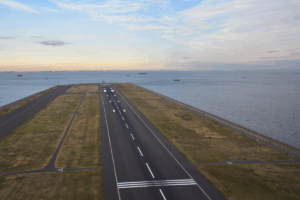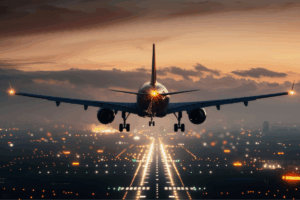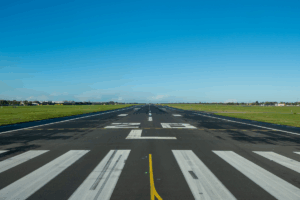La mise à niveau des systèmes est souvent nécessaire pour la plupart des technologies, y compris les feux de piste. Faire des choix éclairés en matière de système de balisage permet non seulement d'assurer la sécurité et l'efficacité de vos pistes, mais aussi d'ouvrir votre aéroport à des revenus supplémentaires et à des possibilités d'expansion.
Dans le blog de ce mois-ci, nous abordons cinq considérations clés qui, selon nous, devraient guider vos décisions d'achat.
Ne considérez que les types d'éclairage dont vous avez besoin
Il n'existe pas de solution unique pour le balisage des pistes d'aéroport. Chaque système est basé sur les besoins spécifiques et la configuration de l'aéroport. Compte tenu des différents types de balisage de pistes et de voies de circulation disponibles, il est essentiel de savoir de quels types de balisage vous avez besoin.
Par exemple, les grands aéroports dotés de plusieurs pistes et voies de circulation fonctionnant 24 heures sur 24 nécessitent généralement un système robuste et complexe comprenant des feux de bord de piste, des feux d'axe, des feux de seuil et des feux de zone de toucher des roues. La sécurité des mouvements au sol aux intersections piste/voie de circulation et le long de la voie de circulation peut également être assurée par des feux de bord de voie de circulation, des feux d'axe, des feux de protection de piste et des feux de barre d'arrêt.
Les exploitants de grands aéroports devraient également envisager d'éclairer les aires de trafic afin de guider les aéronefs en toute sécurité lorsqu'ils stationnent ou se déplacent aux portes d'embarquement, ainsi que d'éclairer les panneaux de signalisation des aérodromes afin de fournir des informations directionnelles aux pilotes.
Les petites pistes d'atterrissage régionales et rurales qui ne fonctionnent que pendant la journée, qui n'ont qu'une seule piste ou qui sont conçues pour accueillir uniquement de petits avions, n'auront pas besoin de l'installation complète requise dans les grands aéroports. Toutefois, les plans de modernisation doivent tenir compte des objectifs de croissance future afin de faciliter l'expansion le moment venu.
Adoption d'une technologie LED avancée
Bien que certains aéroports utilisent encore des lampes halogènes sur leurs pistes et voies de circulation, nous sommes actuellement à l'ère des LED, et rien ne laisse présager qu'elles disparaîtront. Si vous n'êtes pas encore passé aux LED, vous devriez sérieusement envisager de le faire, d'autant plus que les lampes halogènes sont de plus en plus rares et difficiles à obtenir. La plupart des fabricants, tels que GE et Osram, ne produisent plus de lampes halogènes.
La bonne nouvelle, c'est qu'il n'y a pratiquement aucun inconvénient à passer aux LED. Elles constituent l'étalon-or de la technologie de l'éclairage en raison des nombreux avantages qu'elles apportent aux exploitants d'aéroports. Elles durent plus longtemps que les autres ampoules, consomment moins d'énergie et nécessitent une maintenance moins fréquente, ce qui se traduit par d'importantes économies que vous pouvez utiliser pour innover dans différents domaines de votre aéroport.
Cependant, les LED ne servent pas uniquement à réduire les coûts. Elles fournissent un éclairage puissant et fiable qui renforce la sécurité du trafic aérien et des opérations au sol, ce qui en fait le choix le plus évident pour les aéroports modernes qui cherchent à accroître leur efficacité, à augmenter leurs revenus et à minimiser leur impact sur l'environnement grâce à l'efficacité énergétique avancée des LED.
Plus d'informations : Comment la technologie LED a révolutionné l'industrie de l'éclairage des aéroports
Exigences en matière d'entretien du matériel d'éclairage
Votre système d'éclairage doit faire l'objet d'un programme d'entretien régulier afin d'assurer son bon fonctionnement. Des mesures d'entretien supplémentaires doivent être prises dans les régions où les chutes de neige sont importantes afin de garantir la sécurité et la régularité des opérations aéroportuaires tout au long de l'année.
Comme nous l'avons mentionné, la technologie LED nécessite beaucoup moins d'entretien que d'autres types de balisage et moins de changements au cours de sa durée de vie. Votre fournisseur de balisage de pistes d'aéroport peut vous conseiller sur les besoins de maintenance de tout système envisagé, afin que vous puissiez faire un choix éclairé dans le cadre de votre budget de maintenance.
Plus d'informations : Routines de maintenance pour le balisage lumineux des pistes et voies de circulation
Respect des lignes directrices réglementaires
Naturellement, tout système de balisage de piste que vous achetez et installez doit être conforme aux réglementations internationales en matière de sécurité afin de garantir la sécurité de votre aéroport pour les pilotes, les passagers, les équipages aériens et au sol, le personnel de l'aéroport et les autres parties prenantes qui utilisent vos installations.
Par exemple, l'Organisation de l'aviation civile internationale (OACI) et l'Administration fédérale de l'aviation (FAA) ont établi des lignes directrices strictes pour les systèmes de balisage des aérodromes, auxquelles tous les exploitants d'aéroports doivent se conformer. Il existe également des réglementations locales qui doivent être respectées.
Votre fournisseur d'aéroport peut vous aider à vous assurer que les mises à niveau de votre système sont entièrement conformes à toutes les instances dirigeantes qui supervisent votre situation géographique.
Retour sur investissement de la modernisation de votre système d'éclairage
Peu de choses arrêtent un projet de modernisation plus rapidement que la constatation de ses coûts initiaux. Dans le cas des systèmes de balisage des pistes, il est essentiel d'adopter une vision à long terme pour apprécier le retour sur votre investissement initial.
Par exemple, même si le coût initial est élevé, les économies réalisées grâce à la réduction de la consommation d'énergie, à la diminution des temps d'arrêt et à la réduction de la fréquence des opérations de maintenance se traduisent par une amélioration significative des résultats au cours des années suivantes. Des bénéfices plus importants peuvent conduire à plus d'innovation, en optimisant davantage vos opérations pour attirer plus de transporteurs, plus de vols et, par conséquent, plus de revenus.
Airport Lighting Company : Votre partenaire de confiance pour l'installation et la modernisation de nouveaux systèmes
Il est essentiel d'avoir un professionnel expérimenté à vos côtés lorsque vous prenez des décisions d'achat pour votre infrastructure d'éclairage de piste. Les ingénieurs experts de Airport Lighting Company se feront un plaisir de collaborer avec vos équipes techniques pour développer une solution rentable qui réponde à vos besoins actuels et vous permette de réaliser d'importantes économies d'énergie et de maintenance sur le long terme.
Considérez-nous comme votre partenaire de confiance en matière de sécurité et d'efficacité des pistes d'aéroport. Depuis 1967, nous aidons les exploitants d'aéroports à trouver des solutions rentables, et nous sommes prêts à vous aider à faire entrer l'infrastructure des pistes de votre aéroport dans le XXIe siècle grâce à des solutions technologiques avancées sur lesquelles vous pouvez compter.
Appelez le Airport Lighting Company pour connaître les dernières technologies en matière de balisage des aéroports.
L'équipe de Airport Lighting Company est à votre disposition pour répondre à vos questions pour savoir comment nos produits technologiques peuvent contribuer à améliorer la sécurité, la fiabilité et l'efficacité de vos pistes d'atterrissage. Appelez le 315-682-6460 pour un service rapide et amical sur lequel vous pouvez compter.


